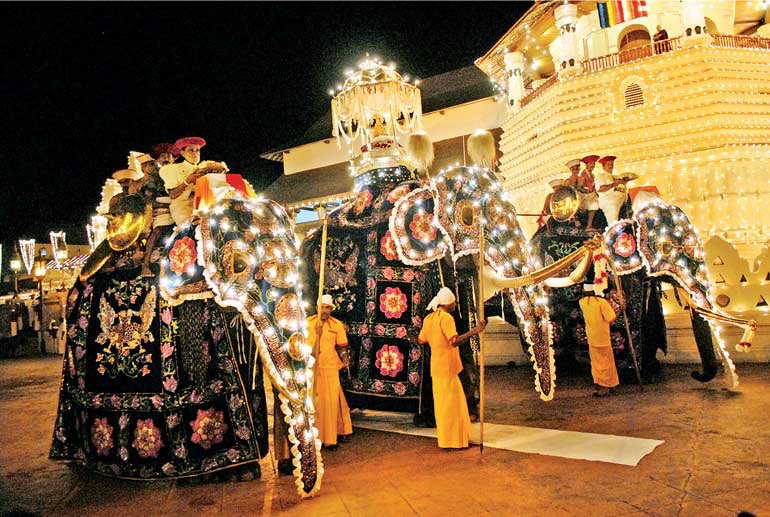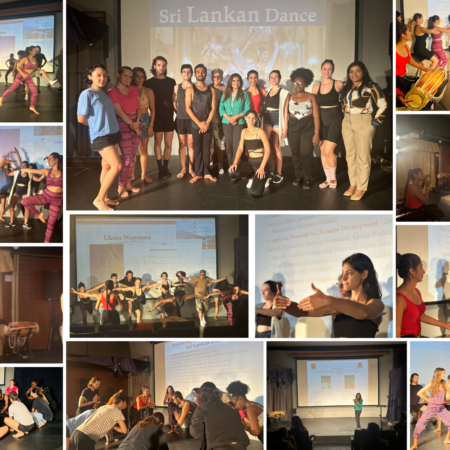By D.C. Ranatunga
Come August – we are in the festive mood. All eyes turn to Kandy where the biggest festival, the Esala Pageant, is held. The annual Sri Dalada Perahera is not only the most glamorous procession held in Sri Lanka but over centuries has developed into a cultural spectacle.
Crowds throng from all parts of the country firstly, to pay homage to the most sacred object of worship for the Buddhists the world over, the Tooth Relic of the Buddha; secondly, to witness the cream of country’s traditional dancers and drummers; and thirdly, to get a taste of what has been preserved for centuries by way of national heritage.
Following tradition, the first step in this year’s Perahera was completed last Wednesday at the auspicious time of 6.24 in the morning with the ‘kap’ planting ceremony at the four devales. It is interpreted as a vow for the Perahera to be conducted.
This year an age-old custom was revived when the log of the tree to be used for the ceremony was cut at the premises of the Alutnuwara Dedimunda devale and brought to Kandy – a distance of about 26 kilometres on an elephant’s back – three of them taking turns. For nearly a century the practice had been stopped and it had been brought in a motor vehicle.
Once the log was brought to the Natha Devale in the Kandy city, it was cut into four pieces and keeping back one piece, the other three were distributed to the Vishnu, Kataragama and Pattini devales. The very evening the processions were started at the premises of the devales for five nights. The ‘kapurala’ – the lay official of each devale – carried the ‘ran ayudhaya’ – a golden weapon, said to have been used by the deity of the devale in battle.
The ‘Kumbal Perahera’ starts parading the streets on Monday 8 August when the Dalada Perahera joins the other processions which move out of the devale precincts. The term ‘kumbal’ is said to have derived from the Esala tree (Cassia Fistula) – from which the log was cut for use as the ‘kap’ – which had been paced in a clay structure resembling a ‘kumbaha’ – an ant hill, round which the processions went.
While spectators can watch the Kumbal Perahera, everyone waits for the more elaborate ‘Randoli Perahera’ that starts on Saturday 13 August and goes on for five nights.
‘Randoli’ which means ‘Queen’s palanquin’, had originally been carried alongside the elephants at the time the Perahera was limited to the processions conducted by the devales. When the Dalada Perahera joined in 1775, King Kirthi Sri Rajasinghe ordered that the palanquins be taken at the end of the Perahera and not alongside the Tooth Relic.
The Maligawa Perahera – the one where the Tooth Relic was taken (it’s a golden casket that resembles the one in which the Relic is enshrined that is taken in the Perahera today, obviously due to security reasons) – is held according to a set pattern.
It starts with the ‘kasa karuwo’ – the whip crackers who announce the approach of the Perahera by cracking their whips creating a collective noise for a few minutes continuously. Though it looks a simple operation, it is an art in itself that needs practice and experience.
The whip crackers are followed by the flag bearers who walk in single file on either side of the road. They carry the standards of the different provinces in the Kandyan Kingdom and the temples.
The grandeur of the Perahera was captured in a set of four stamps released in August 1984. The unique issue, designed by artist R.B. Mawilmada became a collectors’ ‘special’ since it was such a rare presentation. Each stamp could also be used separately without disturbing the design that depicted a specific part of the Perahera.
The first official to ride an elephant is the ‘Peramune Rala’, who in earlier times carried the mandate from the king to hold the Perahera. This has now been replaced by the ‘Lekam Mitiya’ – an ola manuscript which is a register of the lands, the tenants and the services due to be performed by them.
The ‘Gajanayaka Nilame’ – the head of the king’s elephant stables during the time of the ancient kings – is the next official riding an elephant. He carries a silver goad (‘ankusa’), which is the symbol of his authority.
Prior to the arrival of the Maligawa Tusker carrying the relic casket is the ‘Kariyakorale’, who is the official next to the Diyawandana Nilame. He is responsible for all the ceremonies connected with the Maligawa. He does not ride an elephant but he walks attended by minor Maligawa functionaries.
The officials are accompanied by drummers playing martial music using a variety of drums such as the ‘davula’ (drum with both faces covered with cow-hide and played with a stick called ‘kadippu’), ‘tammettam’ (commonly called ‘hewisi’ – a drum with two faces both covered with cow-hide and played with two sticks of cane with a ring at each end), and ‘geta bera’ (drum with two faces producing two different sounds – each face covered with a different type of skin and played with both hands). In addition to these percussion instruments, blowers of ‘horanewas’ (flutes) are in the squads of drummers.
For the ‘ves’ dancers dressed in traditional costumes coming down the generations, this is the great opportunity to display their skills performing different types of dances before several thousand of onlookers amidst whom are large numbers of foreign tourists.
As the ‘Perahera Karunduwa’ – the golden casket – is carried by the Maligawa tusker, crowds get up and worship chanting ‘Sadhu, Sadhu’. A canopy is held over the tusker and ‘pavada’ – white cloth – is spread on its path as a mark of respect and the tusker walks on it.
Maligawa attendants riding two elephants on either side throw white flowers towards the casket symbolising offering flowers to the Sacred Relic. The ‘kavikara maduwa’ – group of singers – deliver ‘strotra gee’ – songs of devotion.
Two lines of dancers – the cream of the troupes taking part in the procession, facing each other on either side of the road with the drummers in the centre, perform in front of the Diyawadana Nilame, the lay custodian of the Tooth Relic, who walks slowly dressed up in his ceremonial clothes. He walks under a ‘muthu kudaya’ – an umbrella adorned with pearls while a battalion carrying ‘mura ayudha’ – security weapons symbolising a platoon providing protection march on either side of the road. A bevy of attendants follow him.
Participation in the Maligawa Perahera is a dream come true for the ‘ves’ dancers who do their best both before the Relic Casket and the Diyawadane Nilame.
In addition to these dancers, numerous groups perform other forms of dances like ‘leekeli’ while the ‘raban’ performers thrill the crowds with their sills.
Nearly 100 elephants take part in the Perahera.
Another custom carried over the years is the presence of torch bearers who carry ‘pandam’ fixed on to long sticks using copra to light them. Coming at the end of the Maligawa Perahera are the four devala processions in the order of Natha, Vishiu, Katargama and Pattini. At the very end are the ‘randolis’.
Randoli Perahera is held on five nights and the Esala Pageant draws to a close with the water-cutting ceremony before dawn on Thursday 18 August followed by the day perahera.






















